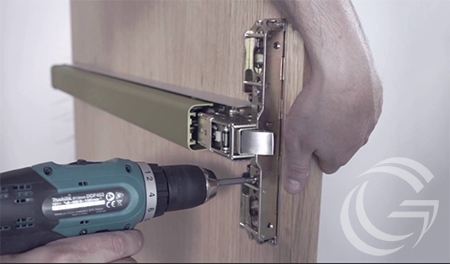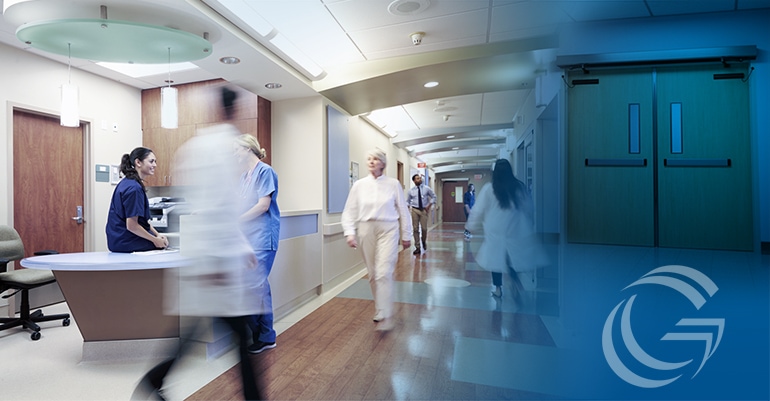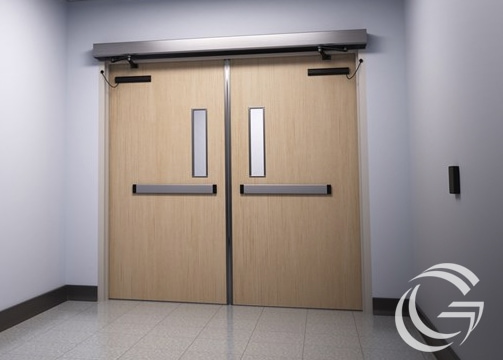Hospitals, healthcare clinics and various other healthcare facilities do have specific requirements for door opening applications and door hardware. Various different areas of a healthcare facility require specific door hardware based on ADA compliance. As an example, patient restrooms must have doors that open out into the room of the patient incase of an emergency rescue situation. On the other hand, restrooms used by the staff in healthcare facilities do not need to abide by these types of requirements.
It is important that doors in healthcare facilities can be identified by their function for a variety of purposes. This is useful in management meetings when working with engineers for electrification purposes and of course, during design and build work.
One key reason for door hardware specifications in healthcare facilities is security. Patient and employee needs must be identified and addressed to ensure that issues with security within the facility do not emerge. An example of this would be patient room doors in behavioral healthcare facilities. Continuous hinges can be used with sloped hospital tips, making it difficult to hang or suspend on them.
The right level of security reduces risk within the healthcare environment, and modern door hardware can be the key with tech such as smart card or even mobile access. Door hardware can also provide the necessary security to protect sensitive areas of the healthcare facility, including Pharmacies and places where patient records and medical supplies are kept.
Safety with Door Hardware in a Medical Facility

This allows for a more rapid departure from a building. However, for hospitals and certainly healthcare facilities with patients who have mental health conditions, further protection is necessary. Of course, this requires ligature-resistant hardware. We have already mentioned one form of this when discussing sloped hinges to reduce the chances of patients hanging things off doors, which has been responsible for a high number of deaths in recent years.
Other options that can provide more safety for patients are concealed mounting, recessed trim, and an internal handle and lever. Features built into door hardware can ensure that patients can’t find attachment points in their rooms that they can use for other purposes.
Typically, door hardware design has been focused on issues within the room when a door is closed and patients have been left by themselves. However, recent installations have shown that it is important to be flexible, particularly when concerned with the issue of life safety. Surveyors of mental healthcare facilities have been asked to put sloped hinges within patient rooms while making sure that corridor doors have continuous hinges. Interestingly, in this situation, the danger is only prevalent if the patient door is not shut. This would go against the procedures of a mental healthcare facility which highlights the other reason for ligature-resistant hardware liability. Door hardware experts must be prepared for new challenges such as making sure that patients cannot harm themselves, and they are considering situations where operating procedures would not have been followed.
Exit Devices for Medical Facility Safety
The importance of the correct exit devices for door hardware in medical facilities has been shown by the countless tragedies of the past. Before modern safety features were used, exit devices were difficult to operate and confusing, resulting in crowds of people getting trapped in dangerous situations such as a building on fire. Even an egress point that is blocked for too long will cause death. In these types of situations people panic, desperately trying to return to the last place they recognize, and often act in confusing impulsive ways. This is why exit devices need to be simple to operate and open the door quickly. A door that opens outward with a device that provides a quick and easy release is less likely to get blocked by a crowd of panicked people.
However, exits in places like healthcare facilities also need to be completely secure, providing challenges for door hardware experts. They must be easy to open without a key or special knowledge from one side, and completely secure from the other. Even if the door exit device isn’t operated, it should open by the weight of a number of people pushing against it, as would be the case in an emergency situation.
Due to this, a single motion egress device will be vital in a critical situation. It is important to consider where these are needed in a healthcare facility, and how they can be used without obstructing the emergency exit with the doors being secured.
Where an exit device needs to be used it is determined by the International Building Code. It is important that the door hardware developers are aware of the codes for the building that they are designing too. Healthcare facilities input is important for accurate information to be used in the door and hardware development.
Panic Device vs. Fire Exit Device
The International Building Code does differentiate between panic devices and fire exit devices. The key operating difference is the possibility to keep the latch retracted on a panic device. Usually, on the interior side of the door, panic devices can be retracted to reduce the usage and sound of the door being opened and repeatedly closed throughout daily operations of the healthcare facility.
In contrast, fire exit devices under the IBC must latch when closed. These devices, used on a fire-rated opening, need to meet the requirements and pass the UL10C Standard for Safety and Positive Pressure Fire Tests of Door Assemblies.
Door hardware is installed in healthcare facilities with a number of key considerations in mind. As we have seen, the right door hardware can help save lives of patients who may try and self-harm or, need it to protect them in emergency situations. All door hardware used in healthcare facilities must be ADA compliant to ensure those with disabilities are kept safe and are not negatively impacted by the door hardware used in these facilities. For instance, doors of restrooms have to be a certain width to allow for wheelchair access. Both employees and patients are taken into consideration when door hardware is specified in healthcare facilities.
G&G Door, Installing Door Hardware
for Life Safety and Security
With the right door hardware, we can keep healthcare facilities secure and safe, protecting patients and vulnerable individuals from danger and ensuring maximum security for certain areas within the building.
If you’re looking for a specific solution for your medical facility doors, don’t hesitate to contact G&G Door Products today. We can help you find exactly what you’re looking for and provide the information that you need to stay safe and secure.
With all these possibilities you’ll be able to find the perfect solution for your medical facility doors, frames, and hardware. Connect with our expert team and find the ultimate options for your life safety needs. Give us a call today to bring our door hardware experience and service into your healthcare facility.


